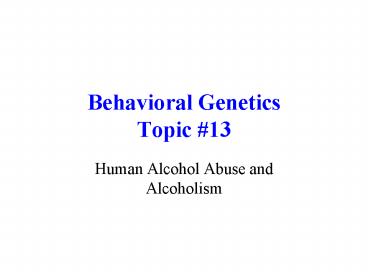Behavioral Genetics Topic PowerPoint PPT Presentation
1 / 34
Title: Behavioral Genetics Topic
1
Behavioral GeneticsTopic 13
- Human Alcohol Abuse and Alcoholism
2
Outline
- Basic Epidemiology
- Genetic Epidemiology (men vs. women)
- Mediating Factors
- Alcohol Sensitivity
- Metabolism (Wall et al. 2001)
- Gene Identification
3
WHAT IS ALCOHOLISM?(NCA, JAMA, 1992, 268
1012-14)
- Alcoholism is a chronic disease with genetic
psychosocial and environmental factors
influencing its development and manifestations. - It is characterized by impaired control over
drinking, preoccupation with alcohol, use of
alcohol despite adverse consequences, and
distorted thinking (e.g., denial).
4
Alcohol Abuse vs. Dependence
- Alcohol Abuse maladaptive pattern of use
manifested by recurrent and significant adverse
consequences. E.g., - Job, school, or home troubles
- DWI
- Alcohol Dependence Cannot control use,
compulsive use. E.g., - Continued use despite recurrent problems
- Physiological tolerance
- Organize live around drinking
5
Some Basic Epidemiology
- Alcoholism is very common in our culture, with
rates much higher in men than women - Alcoholism rates vary markedly across cultures
- Major risk factors include
- Ethnicity
- Other psychiatric disorders
- Early initiation
- Positive family
6
Prevalence of Alcoholism (DSM-IIIR)(Kessler et
al., Arch Gen Psychiatry, 1994 518-19)
Prevalence
7
Cross-cultural Rates of Alcoholism (DSM-III)
(Helzer et al., 1990)
8
Twin Adoption Studies
- In men, twin and adoption studies consistently
implicate the importance of genetic factors, with
heritability estimates of about 50 - In women, findings from twin and adoption studies
are less consistent, with a wide range (0 to
60) of heritability estimates being reported
9
Rates of Temperance Board Registration in Male
Twins(Kendler et al. Arch Gen Psychiatry 1997
54 178-184)
Birth Cohort
10
Gene-To-Behavior Pathway
P1
G1
B1
N1
P2
G2
N2
B2
P3
G3
N3
B3
P4
G4
Neurophy- siological
Genetic
Psychological
Behavioral
11
Inherited Mediator - Criteria
- Associated with, but not a consequence of,
alcoholism - Transmitted in families of alcoholics
- Heritable
- Genetically correlated with alcoholism
12
Inherited Mediator - Sensitivity
- Associated with, but not a consequence of,
alcoholism - Transmitted in families of alcoholics
- Heritable
- Genetically correlated with alcoholism
13
Behavioral Sensitivity(Schuckit)
14
Inherited Mediator - Sensitivity
- Associated with, but not a consequence of,
alcoholism - Transmitted in families of alcoholics
- Heritable
- Genetically correlated with alcoholism
15
(No Transcript)
16
Inherited Mediator - Sensitivity
- Associated with, but not a consequence of,
alcoholism - Transmitted in families of alcoholics
- Heritable
- Genetically correlated with alcoholism
17
Twin Study (Heath, et al.1999)
18
Inherited Mediator - Sensitivity
- Associated with, but not a consequence of,
alcoholism - Transmitted in families of alcoholics
- Heritable
- Genetically correlated with alcoholism
19
Reduced Sensitivity in MZ Co-twins
20
Sensitivity and Drinking
- Schuckit Attenuated response to ETOH is an
inherited risk factor for alcoholism - Finn Heightened response to the (negatively)
reinforcing effects of ETOH is an inherited risk
factor for alcoholism
21
(No Transcript)
22
Sensitivity and Drinking
- Schuckit Attenuated response to ETOH is an
inherited risk factor for alcoholism - Finn Heightened response to the (negatively)
reinforcing effects of ETOH is an inherited risk
factor for alcoholism - Newlin Thompson Biphasic model
23
Blood Alcohol Concentration
Ascending Limb
Descending Limb
24
SONAgtSOA
SOAgtSONA
25
Mediators of Alcoholism Inheritance
- Ethanol Sensitivity
- Comorbid Psychopathology Disinhibitory
psychopathology - Personality Impulsivity, Constraint
- Barin Wave Markers P3 Amplitude
- Metabolism
26
Flushing Response
- Dysphoric effects that occur w/i 15 minutes of
drinking - Heart palpitation
- Facial reddening
- Nausea, dizziness
- There are large ethnic group differences in rate
of flushing metabolic not cultural
27
Pathway of Alcohol Metabolism
NAD
NAD
Alcohol
Acetaldehyde
Acetate
ADH
ALDH
28
ALDH2 Deficiency
- Mutation (ALDH22 v wild-type ALDH21) is a
single nucleotide change in exon 12 that results
in a glu/lys exchange in position 487 - Deficient form of the enzyme carried by approx
50 of Northern East Asians but only 2 of
alcoholics from those regions
29
Wall et al. (2001)
30
Wall et al. (2001)
31
ALDH2 Deficiency Among Japanese
Alcoholics(Higuchi et al. 1994)
Heterozygote Frequency
32
Is ADH Important?
- Four forms, ADH1, ADH2, ADH3, ADH4
- Polymorphism in ADH2
- 1 lower activity
- 2 higher activity (reduced alcoholism rates)
33
Efforts to Identify Genes Influencing Alcoholism
Risk
- Association Studies
- ALDH ADH
- Large of candidate gene studies (dopamine,
serotonin, NP-Y, GABA receptor polymorphisms) - Animal Models
- QTL
- Transgenic/Knockout
- Genome-wide Linkage Analyses
- COGA
34
Summary
- Alcoholism is a common disorder with many known
risk factors - Alcoholism liability is clearly heritable in men
evidence is less consistent in women - Behavioral sensitivity as a model of an inherited
mediator - Metabolism and ALDH/ADH

